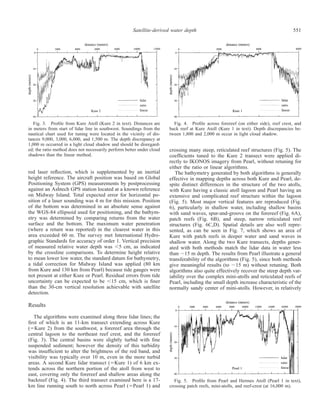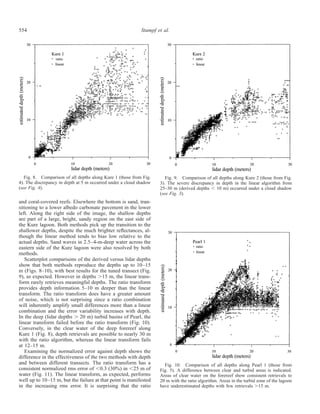This document describes two algorithms for determining water depth from high-resolution satellite imagery: a standard linear transform algorithm and a new ratio transform algorithm. The linear transform requires tuning five parameters and does not work for very low albedo bottoms, while the ratio transform requires tuning only two parameters and can handle low albedo features. Both algorithms were tested on IKONOS imagery of two coral reef atolls in the Hawaiian Islands against lidar bathymetry data. The ratio transform performed as well as the linear transform and was more robust, stable between areas, and able to retrieve depths over 25m. However, it was also slightly noisier and had trouble resolving fine structures below 15-20m depth.

![548 Stumpf et al.
Table 1. Spectral bands for IKONOS, with Landsat-7 ETM for
comparison.
Spectral region
Spectral bands (nm)
IKONOS Landsat-7
Blue
Green
Red
Near-infrared
445–515
510–595
630–700
760–850
450–520
530–610
630–690
780–900
same depth estimation methods can be applied to Landsat
imagery because of the similarity in the spectral bands (Ta-
ble 1).
The standard bathymetry algorithm has a theoretical der-
ivation (Lyzenga 1978) but also incorporates empirical tun-
ing as an inherent part of the depth estimation process. It is
preferable to minimize such tuning, particularly for remote
regions where benthic and water quality parameters can be
hard to measure or estimate. This paper examines an alter-
native bathymetry algorithm and addresses two basic prob-
lems in the application of bathymetry algorithms to mapping
coral reefs: (1) the stability of an algorithm with fixed co-
efficients within and between atolls and (2) the behavior of
the algorithms in describing relative and absolute depths at
various scales.
Materials and methods
Study area—The area under investigation in this paper
includes two coral reef atolls in the northwest Hawaiian Is-
lands. This island chain extends over 1,800 km of the north
Pacific from Nihoa Island at 162ЊW to Kure Atoll at
178.5ЊW. The area encompasses two National Wildlife Ref-
uges, a Hawaiian State Wildlife Sanctuary, and the new U.S.
Northwestern Hawaiian Islands Coral Reef Ecosystem Re-
serve, which is proposed for designation as a U.S. National
Marine Sanctuary. There are 10 emergent atolls and reefs
and several shallow banks. The reef and bank areas include
Ͼ7,000 km2
of area less than 25 fathoms (45 m) in depth
(the absolute maximum depth detectable by passive remote
sensing and a boundary demarcation for some regulated ac-
tivities within the Reserve), making it the largest shallow-
water coral reef area under direct U.S. jurisdiction. The area
is remote, and the two atolls discussed here, Kure Atoll and
Pearl and Hermes Reef (henceforth called Pearl), are located
nearly 2,000 km from Honolulu. The shallow-water envi-
ronments of these two atolls are considerable in area, with
100 km2
at Kure and 500 km2
at Pearl. Kure Atoll was home
to a U.S. Coast Guard Loran station and has accurate sound-
ings within the lagoon, but few or no soundings in the fore-
reef area. In addition, outside of a narrow corridor to the
main island, many of the Kure reefs are not mapped in suf-
ficient detail to assure confidence in navigation. Even with
these limitations, Kure has more depth information than
Pearl, where one third of the lagoon has no bathymetric in-
formation at all, and the charts show only the general form
of the maze of mini-atolls and extensive lines of reticulated
reefs within the lagoon.
The atolls have substrates varying from sand to pavement
to live coral, with cover that includes various densities of
algae and smaller corals. The sand is usually coralline and
white with an extremely high albedo in higher energy areas.
With an increasing proportion of coral gravel and rubble, the
sediments tend to have a tan or brown appearance. Pavement
is typically gray to olive brown in appearance, varies from
low to high rugosity, and is often covered with varying den-
sities of algae. In areas where coral is found at high density
at Kure and Pearl, Porites compressa (finger coral) is the
most common species, with other dominant corals including
Montipora capitata (rice coral), Porites lobata (lobe coral),
Montipora flabellata (blue rice coral), and Pocillopora
meandrina (cauliflower coral). Algal cover includes varieties
of red, brown, and green macroalgae, as well as filamentous
turf algae. The reef flats are typically dominated by encrust-
ing coralline algae, with some green algae (e.g., Halimeda
sp.).
Model—The depth estimation method uses the reflectanc-
es for each satellite imagery band, calculated with the sensor
calibration files and corrected for atmospheric effects. The
reflectance of the water, Rw, which includes the bottom
where the water is optically shallow, is defined as
L ()w
R ϭ (1)w
E ()d
where Lw is the water-leaving radiance, Ed is the downwell-
ing irradiance entering the water, and is the spectral band.
Lw and Rw refer to values above the water surface. Rw is
found by correcting the total reflectance RT for the aerosol
and surface reflectance, as estimated by the near-IR band,
and for the Rayleigh reflectance Rr (Eq. 2).
Rw ϭ RT(i) Ϫ Y(i)RT(IR) Ϫ Rr(i) (2)
Y is the constant to correct for spectral variation (equivalent
to the Angstrom exponent in Gordon et al. [1983]), subscript
i denotes a visible channel, and subscript IR denotes the
near-IR channel. RT is found from Eq. 3.
L ( )/E ( )T i 0 i
R ( ) ϭ (3)T i 2
(1/r )T ( )T ( )cos 0 i 1 i 0
LT is the (total) radiance measured at the satellite, E0 is the
solar constant, r is the earth–sun distance in astronomical
units, 0 is the solar zenith angle, and T0 and T1 are the
transmission coefficients for sun-to-earth and earth-to-satel-
lite, respectively.
The atmospheric correction is based on the algorithm de-
veloped by Gordon et al. (1983) for the Coastal Zone Color
Scanner (CZCS) and by Stumpf and Pennock (1989) for the
Advanced Very High Resolution Radiometer (AVHRR) and
is similar to that recommended for Landsat (Chavez 1996;
Zhang et al. 1999). The Y coefficient in Eq. 2 depends on
aerosol type. For IKONOS, the correction presumes a mar-
itime atmosphere with a spectral variation similar to that of
the water surface specular reflectance. This proves to be a
reasonable assumption here; however, separation of the aero-
sol correction (with a scale of hundreds of meters) from the
specular surface reflectance correction (with a scale of tens](https://image.slidesharecdn.com/stumpfetal2003-150221233946-conversion-gate02/85/Stumpf-et-al-2003-2-320.jpg)
![549Satellite-derived water depth
Fig. 1. Log transformation used for ratio algorithm with data
from Kure Atoll. The lines of constant depth are also lines of fixed
ratio (0.3 m is also the blue to green ratio of 0.975; 18 m is a ratio
of 1.251). Depths were assigned to the constant ratio lines using the
tuning described in this paper. The dashed line shows the approxi-
mate values for a sand bottom that has the same albedo at all depths.
The attenuation of light with depth means that features have lower
Rw in deeper water, regardless of their intrinsic albedo. A decrease
in albedo causes values to move down the lines of constant ratio.
‘‘High Ad’’ indicates carbonate sand of nominally similar albedo at
both 0.3 and 18 m. ‘‘Low Ad’’ indicates similar albedo over dense
algal cover at both depths.
of meters) might be required for more generic use of IKO-
NOS data. Although IKONOS does not have onboard cali-
bration, postlaunch calibrations have been established by the
commercial vendor, Space Imaging. Additional comparisons
with Landsat-7, which does have onboard calibration, as well
as the sea-viewing wide field-of-view sensor (SeaWiFS),
might aid in calibration for future work. Residual miscali-
bration will result in alteration of the atmospheric model of
choice and, to a lesser degree, in the empirical coefficients
chosen for the depth estimation algorithms.
Bathymetry—Linear transform: Light is attenuated expo-
nentially with depth in the water column, with the change
expressed by Beer’s Law (Eq. 4).
L(z) ϭ L(0)exp(ϪKz) (4)
K is the attenuation coefficient and z is the depth. Any anal-
ysis of light with depth must take into account this expo-
nential decrease in radiance with depth. Lyzenga (1978)
showed that the relationship of observed reflectance (or ra-
diance) to depth and bottom albedo could be described as
Rw ϭ (Ad Ϫ Rϱ)exp(Ϫgz) ϩ Rϱ (5)
where Rϱ is the water column reflectance if the water were
optically deep, Ad is the bottom albedo, z is the depth, and
g is a function of the diffuse attenuation coefficients for both
downwelling and upwelling light. Equation 5 can be rear-
ranged to describe the depth in terms of the reflectances and
the albedo (Eq. 6).
z ϭ gϪ1
[ln(Ad Ϫ Rϱ) Ϫ ln(Rw Ϫ Rϱ)] (6)
The estimation of depth from a single band using Eq. 6
will depend on the albedo Ad, with a decrease in albedo
resulting in an increase in the estimated depth. Lyzenga
(1978, 1985) showed that two bands could provide a cor-
rection for albedo in finding the depth and created from Eq.
6 the linear solution in Eq. 7.
Z ϭ a0 ϩ aiXi ϩ ajXj (7)
where
Xi ϭ ln[Rw(i) Ϫ Rϱ(i)] (8)
The constants a0, ai, and aj usually are determined from mul-
tiple linear regression (or a similar technique). For any so-
lution for depth from passive systems, variations in water
clarity and spectral variation in absorption pose additional
complications (Philpot 1989; Van Hengel and Spitzer 1991).
The linear transform solution above has five variables that
must be determined empirically: Rϱ(i), Rϱ(j), a0, ai, and aj.
Having to adjust five empirical coefficients can be problem-
atic for large areas, even with relatively small variations in
water quality conditions. In addition, when the bottom al-
bedo is low, as can occur with dense macroalgae or seagrass,
then Ad is less than Rϱ. As a result, the depth cannot be found
without using an entirely new algorithm, because X is un-
defined if (Rw Ϫ Rϱ) is negative (logarithm of a negative
number).
Ratio transform: The problem of mapping shallow-water
areas with significantly lower reflectance than adjacent, op-
tically deep waters provided the initial motivation to develop
an alternative algorithm. Because we are interested in map-
ping relatively large and remote coral reef areas, we also
searched for an alternative solution that has fewer parame-
ters, thereby requiring less empirical tuning and having the
potential of being more robust over variable bottom habitats.
With bands having different water absorptions, one band
will have arithmetically lesser values than the other. Ac-
cordingly, as the log values change with depth, the ratio will
change (Fig. 1). As the depth increases, while the reflectance
of both bands decreases, ln(Rw) of the band with higher ab-
sorption (green) will decrease proportionately faster than
ln(Rw) of the band with lower absorption (blue). According-
ly, the ratio of the blue to the green will increase. A ratio
transform will also compensate implicitly for variable bot-
tom type. A change in bottom albedo affects both bands
similarly (cf. Philpot 1989), but changes in depth affect the
high absorption band more. Accordingly, the change in ratio
because of depth is much greater than that caused by change](https://image.slidesharecdn.com/stumpfetal2003-150221233946-conversion-gate02/85/Stumpf-et-al-2003-3-320.jpg)






